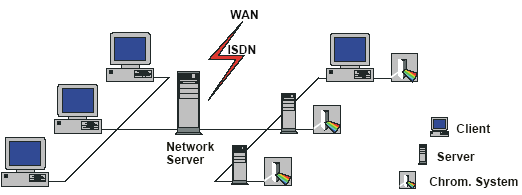The Network
![]() Network Installation
Network Installation
The Client, the Chromatography Server, and the Datasource can be installed on different computers. They are connected via the network and the corresponding network server. Each chromatography server can operate up to six chromatography systems (Timebases).
The client, server, and datasource are independent units on the network.

On each PC, a server, client, and local datasource are set up during the installation of Chromeleon. Independently of this, each PC can act as "server only" or "client only." Theoretically, each client can access each datasource and each server. In practice, this may not be desirable for safety reasons. Therefore, various options are available to restrict user access:
The Server Configuration program allows you to define the extent of network operation for each Server and each timebase. A server can be made available for the entire network or for certain Access Groups only. The server can be locked either partly or completely. If the server is partly locked, for example, it is still possible to monitor the server, but control of the connected instruments is disabled. In this case, control is reserved for the local client. This distinction also applies to the timebases. If three timebases (TIME1, TIME2, and TIME3) are installed on a server, TIME1 could be completely shared, TIME2 could be excluded from network operation, and TIME3 could be shared for monitoring only.
Datasources and/or their subdirectories can also be protected from undesired access. Depending on the location of the corresponding database (on the local hard disk or a network PC), the respective user or the network administrator decides (by "sharing" a directory) which data can be accessed and by whom. In addition, datasources shared in Windows can be locked in Chromeleon.
In addition, access can be restricted via Passwords or the Chromeleon User Management. If the administrator has enabled access control (in the Security Activation Tool (CmSecure program)), the user must enter a password before being allowed to perform specific operations. The system administrator determines these operations in the User Manager (CmUser program). In this way, the administrator can deny controlling rights or prohibit "locking" of datasources.
Besides, access is not possible if the appropriate license is missing. For example, if a server does not have a Multiple Network Control license and/or if the client does not have a Server Control license, the server cannot be controlled on the network.
Important data are often stored on central data server PCs. If, during data acquisition, the network connection is interrupted or the data server PC crashes, data acquisition should continue, nevertheless. All data that are relevant for the Chromeleon server are locally stored on the server's hard disk, thus ensuring that data acquisition will not be interrupted in case of a network failure (see Network Failure Protection).
In addition to allowing data exchange within a local area on a Windows, Novell, DEC, or UNIX network (LAN), it is possible to transfer data across huge distances (WAN) via ISDN. The basic requirement for any type of network operation is the availability of the corresponding network drivers for Windows.
![]() Tip:
Tip:
The Administrator Help section provides more information; refer to How to …: Working with Files, Databases, and Networks: